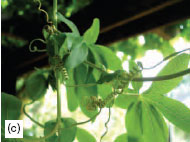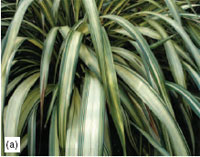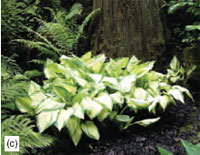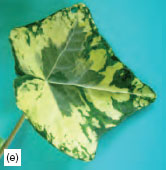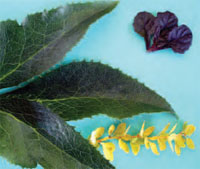Adaptations
Content
The features of typical plants are given, but there are many variations on the basic form of the stem, root and leaves. Adaptations to plant organs have enabled plants to compete and survive in their habitat. Plants adapted to dry areas (xerophytes), such as cacti, have leaves reduced to protective spines and stems capable of photosynthesis. Thorns, which are modified branches growing from axillary buds, also have a protective function, e.g. hawthorn (Crataegus). Prickles are specialized outgrowths of the stem epidermis, which not only protect but also assist the plant in scrambling over other vegetation, as in wild roses. Several species possess leaves modified specifically for climbing in the form of tendrils, as in many members of the Leguminosae family, and Clematis climb by means of a sensitive, elongated leaf stalk, which twists round their support. In runner beans, honeysuckle (Lonicera) and Wisteria, twining stems wind around other uprights for support. Others are able to climb with the help of adventitious roots such as ivies, and Virginia Creeper (Parthenocissus). Epiphytes are physically attached to aerial parts of other plants for support; they absorb and sometimes store water in aerial roots, as in some orchids. To survive an environment with very low nutrient levels, such as the sphagnum peat moor, some plants have evolved methods of trapping insects and utilizing the soluble products of their decomposed prey. These insectivorous plants include the native sundew (Drosera) and butterwort (Pinguicula spp.), which trap their prey with sticky glands on their leaves. Pitcher plants (Sarracenia spp.) have leaves that form containers which insects are able to enter into, but are prevented from escaping by slippery surfaces or barriers of stiff hairs. The Venus flytrap (Dionaea muscpula) has leaves that are hinged so that they can snap shut on their prey when it alights on one of the trigger hairs. Plants found growing in coastal areas have adaptations that allow them to withstand high salt levels, e.g. salt glands as found in the cord grass (Spartina spp.) or succulent tissues in 'scurvy grass' (Cochlearia), both inhabitants of coastal areas. Other modifications in plants are dealt with elsewhere. This includes the use of stems and roots as food and water storage organs (see vegetative propagation). Leaf adaptations
Buds and bulbs are composed mainly of leaf tissue. In the former, the leaves (called scales) are reduced in size, hard, and brown rather than green. They tightly overlap each other, giving protection to the delicate meristematic tissues inside the bud. In a bulb, the succulent, lightcoloured scale leaves contain all the nutrients and moisture necessary for the bulb’s emergence. The scales are packed densely together around the terminal bud, minimizing the risk that might be caused by extremes of climate, or by pests such as eelworms or mice. In the houseplant Bryophyllum daigremontianum, the succulent leaf bears adventitious buds that are able to develop into young plantlets. Leaf form The novice gardener may easily overlook the importance that the shape, texture, venation, colour and size of leaves can contribute to the general appearance of a garden, as they focus more on the floral side of things. Flowers are the most striking feature, but they are often short-lived. It should be emphasized that the dominant theme in most gardens is the foliage and not the flowers (see Figures 5.7 and 5.8). The possibilities for contrast are almost endless when these five
Secondly, leaf texture is also important. Most species have quite smooth textured leaves. Notably different are Verbascum olympicum, Stachys byzantina (Lamb’s tongue) and the alpine Leontopodium alpinum (Edelweiss) which all are woolly in texture. Glossy-leaved species such as Ilex aquifolium (Holly), and Pieris japonica provide a striking appearance. Thirdly, the plant kingdom exhibits a wide variety of leaf colour tones (see Figure 5.8). The conifer, Juniperus chinensis (Chinese juniper), shrubs of the Ceanothus genus, and Helleborus viridus (Christmas rose) are examples of dark-leaved plants. Notable examples of plants with light-coloured leaves are the tree Robinia pseudoacacia (false acacia), the climber Humulus lupulinus 'Aureus' (common hop) and the creeping herbaceous perennial, Lysimachia nummularia 'Aurea' (Creeping Jenny). Plants with unusually coloured foliage may also be briefly mentioned: the small tree Prunus 'Shirofugen' (bronze-red), the sub-shrub Senecio maritima (silver-grey) and the shade perennial Ajuga reptans 'Atropurpurea' (bronze-purple). Variegation (the presence of both yellow and green areas on the leaf) gives a novel appearance to the plant (see Figures 5.6 and 10.11). Example species are Aucuba japonica (Laurel), Euonymus fortunei and Glechoma hederacea (Ground Ivy). Fourthly, in autumn, the leaves of several tree, shrub and climber species change from green to a striking orange-red colour. Acer japonicum (Japanese maple), Euonymus alatus (Winged spindle), and Parthenocissus tri-cuspidata (Boston ivy) are examples. |
||||||||||||||||||||||||||||||||||

